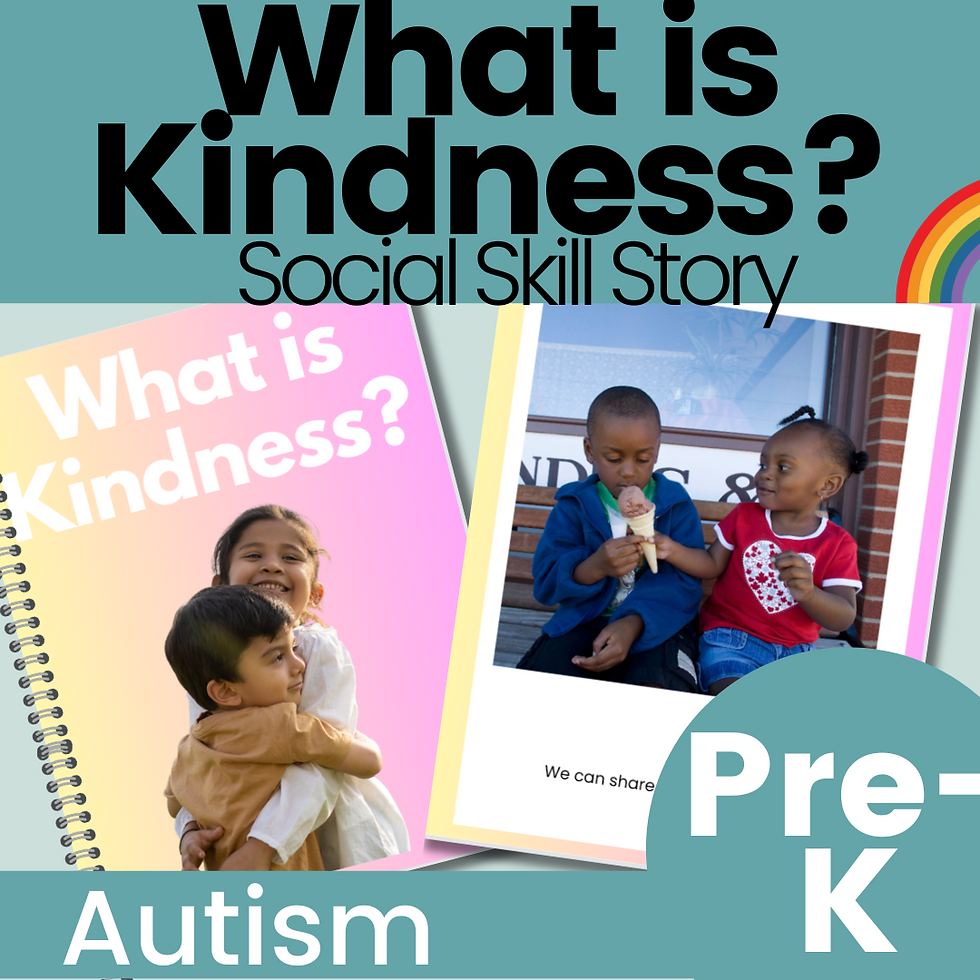World Kindness Day: Fostering Empathy in Autism
- Autism-Talk

- Jan 19, 2024
- 6 min read
Updated: Feb 23, 2024

How Can We Celebrate World Kindness Day?
I love the idea of "World Kindness Day" but as a past early childhood special education teacher and current autism parent I really struggled with ways to make the day meaningful. The more I thought about it, though, I realized at the heart of kindness is empathy. For children with autism, however, understanding empathy can be a real challenge due to many reasons. Despite the challenges, as a neurodiverse parent of several children, I believe it is one of my most important responsibilities not only to ensure that others are kind to my children but also to ensure that my children are kind to others and sensitive to their needs. Why is empathy so difficult?

Theory of Mind:
Understanding Others' Perspectives: Children with autism may struggle to grasp that others have different thoughts, feelings, and perspectives. This can make it challenging for them to anticipate how their actions might impact others.
Interpreting Social Cues:
Recognizing Emotions: Reading facial expressions, body language, and other social cues are often more challenging for children with autism. This can lead to difficulties in understanding how others are feeling, making it harder to respond with kindness.
Communication Challenges: Some children with autism may find it challenging to express their intentions or emotions verbally. They may be thinking something that others would interpret as kind but lack the communication skills to convey this to others.

This can lead to misunderstandings, as their peers may struggle to interpret their actions.
Sensory Sensitivities: Children with autism may be more sensitive to sensory stimuli, such as loud noises or bright lights. In overwhelming environments, they may become stressed or anxious, affecting their ability to engage in kind behaviors and making it more likely they will react by lashing out and yelling or hitting, kicking, etc.
Rigidity in Routines: Many children with autism thrive on routine, and unexpected changes can cause stress. Kindness often involves flexibility and adaptability, which can be challenging for those who prefer a structured environment. Often to be kind, we have to overlook something that we think is going to happen, i.e. be line leader, to be kind by offering for someone else to be line leader because it is their birthday, for instance.

Impulsivity: Some children with autism may struggle to think before they act without considering the consequences of their actions. This can impact their ability to respond with kindness, especially in social situations.
Despite the difficulties, I firmly believe, as a parent and former teacher, that there is nothing more critical than assisting children in understanding the importance of respecting others and being as kind as they can be in any situation. This endeavor not only contributes to their well-being but also plays a pivotal role in fostering a kinder world for them and everyone around them.
In this blog post, we'll explore why teaching empathy is crucial, for all children, including children with autism.
The Significance of World Kindness Day for Autism
World Kindness Day is not just about random acts of goodwill; it's an opportunity to highlight the importance of empathy, especially for children with autism. Empathy forms the foundation of meaningful connections, friendships, and successful relationships. As parents and educators, our mission is not only to raise bright minds but to nurture kind hearts that contribute positively to the world.
Using Social Skill Stories to Teach Empathy & Kindness

It can be tempting to just sit back and hope that kids understand the importance of doing nice things for others. While this may sometimes happen, it is more often the case that we need to directly instruct children in this area. This is particularly true for children with autism.
Social stories offer a straightforward method for introducing crucial social skills to children with autism. They are ideal because they can take abstract subjects, such as "being kind," and make them more concrete for children. These stories can specifically focus on kindness or address related topics, such as understanding other people's points of view or using kind and polite words. Ideally, the stories provide specific examples of how a child can engage in the desired behavior, emphasizing positive actions rather than stressing what the child should avoid.
Reading a social skill story when children are in a good mood and not facing any regulation issues can be an excellent way to introduce a topic without making them feel like they are doing something wrong or are not "good enough." This approach is ideal because many children with autism are sensitive to criticism. For instance, if a neurodiverse child is told, "Why can't you just be nice! You cannot just tell someone they smell!" they are likely to feel defensive. Instead of absorbing the information that it is not kind to tell someone they smell, they may become angry and less likely to listen to anything the adult has to say. On the other hand, if the adult frequently reads a book about how others might feel in different situations or why it is important to think before speaking, the child is more likely to take in the information and at least consider it.
Additionally, a well-written social story can provide a concrete reason for the "why" behind doing things that may seem arbitrary to a neurodiverse child. Many children with autism are resistant to doing things "just because," but when they truly understand why it is more beneficial, they are more likely to independently try to revise their own behavior. This is important because behavior driven by internal understanding is much more likely to become a permanent behavior.
Reinforcement
Obviously, we do not want to raise children that only engage in kind behavior when they think they will receive a reward, however, sometimes it is important to understand that in the beginning of learning any new skill, reinforcement is often necessary. It is often helpful to think of reinforcement as a stepping stone or a bridge to getting the desired behavior. Once the behavior is easier for the child and feels more natural to them, they will no longer need the reinforcement.

Reinforcement, however, does not always have to involve tangible items such as stickers or candy. Being carefully observant and socially reinforcing even the tiniest kind action can be effective. For example, actions like waiting for a turn briefly without pushing the child in front of them or allowing another child to play close to them when they usually display aggression in the presence of others could be reinforced with descriptive words or gestures, such as a hug or pat on the back, if the child responds positively to such forms of reinforcement.
It is important to remember that if the child has been socially reinforced for a significant time period and they are not increasing the behaviors you are wanting to see, they may still need something tangible to encourage them. It is after all only "reinforcement" if they find it reinforcing!
If you need to begin with tangible reinforcers or rewards you can utilize a sticker chart or a punch card so that the child is visually reminded of the behavior and so that the reinforcement is easier to gradually fade. For instance, if using a sticker chart, you would begin by giving a reward after 2 stickers, then move to 4, etc.
Conclusion
Navigating World Kindness Day with children, especially those with autism, can present unique challenges due to difficulties in understanding and expressing empathy. The underlying reasons, such as theory of mind challenges, interpreting social cues, communication obstacles, sensory sensitivities, rigidity in routines, and impulsivity, shed light on the complexities these children face in fostering kind behaviors.
Despite these challenges, as a parent and former teacher, I firmly believe in the paramount importance of instilling the values of empathy and kindness in all children. It's not just about ensuring others are kind to our children; it's about empowering them to be kind to others and sensitive to their needs. Teaching empathy is a critical tool in bridging the gap between abstract concepts and concrete understanding.
Social stories offer a structured and engaging way to introduce social skills, making kindness a tangible and relatable concept for children with autism. These stories can address specific behaviors, provide examples, and offer a positive approach to learning without making the child feel criticized. Additionally, well-crafted social stories can provide a clear "why" behind certain behaviors, helping neurodiverse children understand the benefits and encouraging independent revisions of their behavior.
While reinforcement, initially in tangible forms, may be necessary to encourage kind behavior, it's essential to transition towards intrinsic reinforcement through careful observation and social reinforcement. Over time, as the behavior becomes more natural, tangible reinforcement can be gradually faded. Sticker charts or punch cards serve as visual reminders and aids in the reinforcement process, allowing for a smoother transition.
In essence, the journey to teach kindness and empathy to children with autism may have its challenges, but it is a rewarding and essential endeavor. By embracing these challenges with patience, understanding, and effective tools like social stories and reinforcement strategies, we contribute not only to the well-being of our children but also to fostering a kinder world for everyone.
Using Social Skill Stories to Teach Social Skills
Using social stories can be so helpful for teaching a variety of social skills. Try this free Taking Turns Social Skill Story
Additional resources
Looking for some additional resources on this topic? Check these out.



When I Get Mad Autism Social Skill Story & Visuals to Teach Coping Strategies (teacherspayteachers.com)
%20(21).png)





Comments